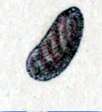Stomatella lintricula
Stomatella lintricula is a species of sea snail, a marine gastropod mollusk in the family Trochidae, the top snails.[2]
| Stomatella lintricula | |
|---|---|
 | |
| Drawing of a shell of Stomatella lintricula | |
| Scientific classification | |
| Kingdom: | Animalia |
| Phylum: | Mollusca |
| Class: | Gastropoda |
| Clade: | Vetigastropoda |
| Order: | Trochida |
| Superfamily: | Trochoidea |
| Family: | Trochidae |
| Genus: | Stomatella |
| Species: | S. lintricula |
| Binomial name | |
| Stomatella lintricula (A. Adams, 1850) [1] | |
| Synonyms[2] | |
| |
Description
The thin, fragile, oblong shell is shaped like a Haliotis. Its back is convex. It is all over very delicately striated. It is flesh-colored, spotted with red. The small spire is nearly terminal and laterally inclined. The open aperture is very much lengthened.[3]
Schepman gives a somewhat divergent description: the posterior part of the shell is nearly entirely yellowish-white with a green tinge, moreover a few smaller patches of the same colour are dispersed over the anterior part, a few dark spiral lines are more conspicuous on the posterior part. The surface is covered with very fine, close-set spiral and by more remote concentric striae. The species may be easily recognized by its very elongate shape.[4]
Distribution
This marine species occurs in the Red Sea, in the Indo-Pacific (Indo-China, Indo-Malaysia, the Philippines, Japan) and off Queensland, Australia.
References
- Adams, A. 1850. An arrangement of Stomatellidae, including the characters of a new genus Cumingia, with some additional generic characters. Proceedings of the Zoological Society of London 1850(18): 29-40, pl. 8
- Marshall, B. (2013). Stomatella lintricula (A. Adams, 1850). Accessed through: World Register of Marine Species at http://www.marinespecies.org/aphia.php?p=taxdetails&id=720374 on 2014-04-05
- H.A. Pilsbry (1890) Manual of Conchology XII; Academy of Natural Sciences, Philadelphia, 1890 (described as Gena lentricula)
- Schepman 1908-1913, The Prosobranchia of the Siboga Expedition; Leyden,E. J. Brill,1908-13 (described as Gena lintricula)
- Proceedings of the Zoological Society of London. pt. 18-19 (1850-1851)
- Adams, A. 1854. Monograph of Stomatellinae. A sub-family of Trochidae. 827-846, pls 173-175 in Sowerby, G.B. (ed). Thesaurus Conchyliorum. London : Sowerby Vol. 2.
- Brazier, J. 1877. Continuation of the Mollusca collected during the Chevert Expedition. Proceedings of the Linnean Society of New South Wales 2: 41-53
- Habe, T. 1964. Shells of the Western Pacific in color. Osaka : Hoikusha Vol. 2 233 pp., 66 pls.
- Higo, S., Callomon, P. & Goto, Y. (2001) Catalogue and Bibliography of the Marine Shell-Bearing Mollusca of Japan. Gastropoda Bivalvia Polyplacophora Scaphopoda Type Figures. Elle Scientific Publications, Yao, Japan, 208 pp